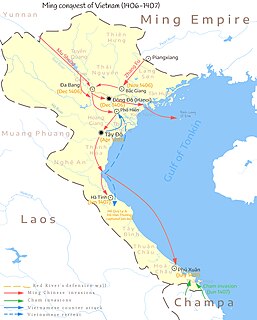
The Ming dynasty, officially the Great Ming, was the ruling dynasty of China from 1368 to 1644 following the collapse of the Mongol-led Yuan dynasty. The Ming dynasty was the last imperial dynasty of China ruled by Han Chinese. Although the primary capital of Beijing fell in 1644 to a rebellion led by Li Zicheng, numerous rump regimes ruled by remnants of the Ming imperial family—collectively called the Southern Ming—survived until 1662.

Ming Yuzhen was a peasant who established the dynasty of Ming Xia during the late Yuan dynasty in China.

Arisaema is a large and diverse genus of the flowering plant family Araceae. The largest concentration of species is in China and Japan, with other species native to other parts of southern Asia as well as eastern and central Africa, Mexico and eastern North America. Asiatic species are often called cobra lilies, while western species are often called jack-in-the-pulpit; both names refer to the distinctive appearance of the flower, which consists of an erect central spadix rising from a spathe.
The military conquests of the Ming dynasty were instrumental to the dynasty's hold on power during the early Ming.
Lan Yu was a Chinese military general and politician who contributed to the founding of the Ming Dynasty. His ancestral home was in present-day Dingyuan County, Anhui. In 1393, Lan was accused of plotting a rebellion and put to death by the Hongwu Emperor. About 15,000 people were implicated in the case and executed.

Euscorpius is a genus of scorpions, commonly called small wood-scorpions. It presently contains 17 species and is the type genus of the family Euscorpiidae - long included in the Chactidae - and the subfamily Euscorpiinae.

Heterometrus, whose members are also known by the collective vernacular name giant forest scorpions, is a genus of scorpions belonging to the family Scorpionidae. It is distributed widely across tropical and subtropical southeastern Asia, including Cambodia, Laos, Thailand, Vietnam, India, Sri Lanka, Bangladesh, Nepal, and China (Tibet). It is notable for containing some of the largest living species of scorpions.

Mesobuthus martensii is a species of scorpion in the family Buthidae. Its common names include Chinese scorpion, Manchurian scorpion, Chinese armor-tail scorpion and Chinese golden scorpion. Despite its common name, this scorpion is not only found in Manchuria or China, but also in Mongolia and Japan. Its preferred habitat is warm, dry areas with little vegetation. M. martensii can grow to about 6 centimetres (2.4 in) long, with females usually slightly larger, and has a life-span of about 4 to 6 years.

The Ming–Hồ War or the Ming conquest of Đại Ngu was a military invasion of Đại Việt by the Ming dynasty of China. The campaign began with Ming intervention in support of a rival faction to the Hồ dynasty which ruled Đại Ngu, but ended with the incorporation of Đại Việt into the Ming dynasty as the province of Jiaozhi. The invasion is acknowledged by recent historians as one of the most important wars of the late medieval period, whereas both sides, especially the Ming, used the most advanced weapons in the world at the time.

Euscorpiops is a genus of scorpion in the family Euscorpiidae.

Scorpiops is a genus of scorpions in the family Euscorpiidae. It is distributed throughout much of Asia. The taxonomy of the group is unclear because new species and subgenera are described often, and one subgroup may represent a species complex.

Scorpiops atomatus is a species of scorpion in the Euscorpiidae family, first found in Tibet and Yunnan, China.

Scorpiops langxian is a species of scorpion in the family Euscorpiidae, first found in Tibet, China.

Scorpiops luridus is a species of scorpion in the Euscorpiidae family, first found in Tibet and Yunnan, China.

Scorpiops pococki is a species of scorpion in the Euscorpiidae family, first found in Tibet and Yunnan, China.
Euscorpiops shidian is a species of scorpion in the Euscorpiidae family, first found in Tibet and Yunnan, China.
Euscorpiops karschi is a species of scorpion in the Euscorpiidae family, first found in Tibet and Yunnan, China.
Chaerilus tessellatus is a species of scorpion in the Chaerilidae family, first found in Tibet and Yunnan, China.

The Ming Xia (1363–1371), officially the Great Xia, was a short-lived Chinese dynasty in modern Sichuan and Chongqing during the chaotic late Yuan dynasty. It was founded by the Red Turban rebel general Ming Yuzhen whose army expelled Yuan loyalists from the region in the late 1350s. He refused to recognize Chen Youliang, who killed the Red Turban leader Xu Shouhui to found the Chen Han empire, so in 1363 Ming declared himself Emperor of Great Xia, with the capital in Chongqing. He defended his empire from Chen Han, and tried, unsuccessfully, to conquer Yunnan from the warlord Basalawarmi. After his death in 1366, his teenaged son Ming Sheng succeeded him, but the empire began to disintegrate into regional military commands. In 1371, the Ming dynasty under emperor Zhu Yuanzhang made a two-pronged attack and conquered Ming Xia relatively easily. Ming Sheng who surrendered was exiled to Goryeo, and became the progenitor of the Korean Namwon Seung clan, Yeonan Myeong clan and Seochok Myeong clan.
Wilson R. Lourenço is a French-Brazilian arachnologist specializing in scorpions.











